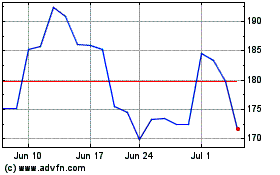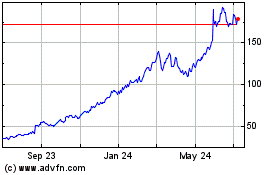With costs for everything from apparel to food on the rise,
retailers are waging a price war this back-to-school shopping
season.
Apparel, the season's top-selling category for school-aged
children, is bracing for the first major cotton cost inflation of
as much as 20% the first time in at least a decade. The recent
weeks' price declines in the commodity don't help, because stores
paid for their goods about six to nine months earlier.
Retailers also are trying to gauge whether they have room to
pass on any of the higher costs to shoppers, whose budgets are
limited by higher gasoline and food prices. Consumer spending has
declined as Americans chose to save more amid a sputtering job
market and weak economic growth.
Spending on clothing and school supplies for children in grades
K-12 is expected to decline this back-to-school season, a National
Retail Federation survey showed.
Shoppers are already paying attention to prices. A July Deloitte
survey showed 70% of respondents with school-age children said
higher food and energy prices may lower their spending this
summer.
About 30% of consumers believe prices on new back-to-school
merchandise are higher and nearly two-thirds say low prices, far
above other factors, are their biggest purchase consideration, the
survey showed.
"Low prices continue to be what will bring customers to stores,"
said Alison Paul, who heads Deloitte's retail practice. "Retailers
are getting more scientific about which items they put on
promotions versus the items they leave on regular prices. There's a
delicate balance. You have to be very sharp with those top selling
items."
For popular basic items like jeans, where cotton use is
significant, some retailers may choose to absorb higher costs,
sometimes even selling them at a loss, in order to stay competitive
and drive traffic, she said.
Meanwhile, stores are opting to raise prices on products
catering to more affluent shoppers, or are more exclusive to their
offerings that will give them more pricing power, analysts said. So
far, that strategy appeared to have worked.
"Having differentiated and new products is key," apparel giant
VF Corp. Chief Financial Officer Bob Shearer said in an interview.
"As consumers make decisions around gas versus apparel, every
dollar just becomes more important."
For instance, updating its jeans with different fabrics, sizes,
fits and new styles has allowed VF (VFC) to raise prices on its
Wrangler and Lee jeans sold respectively to retailers like Wal-Mart
Stores Inc. (WMT) and J.C. Penney Co. (JCP) with little price
resistance so far, Shearer said.
"We are at the very forefront of price increase" this
back-to-school season, Shearer said. "What we know is what we've
seen. No one knows really what to expect. We are obviously
optimistic."
Most retailers declined to be more specific about their pricing
strategy or detail the specific amount of price hikes they have
taken or plan to. Teen retailer Buckle Inc. (BKE) is an exception.
It said it raised its men's clothing prices by about 8% in July and
about 3% for women's clothing.
Raising Prices And Promoting At The Same Time
Retailers' July same-store sales results showed consumers are
under pressure and still focused mainly on food and life's
necessities unless given a compelling reason, such as deep
discounts, to open their wallets.
"Retailers could be quietly raising prices and promoting at the
same time," said Erin Armendinger, managing director of the Wharton
School's Jay H. Baker Retailing Center. "It's going to be a very
promotional season."
At department store operator J.C. Penney, the company began late
last year to test different prices on various merchandise to gauge
consumer response.
This season it's holding prices steady on lower-priced basic
items but may reduce the amount of time it keeps those products at
promotional prices to help bolster profit, spokeswoman Rebecca
Winter said.
"We've become much more surgical in our pricing," she said,
adding that Penney also hasn't met with resistance when it raised
prices on newer and fashionable assortment.
Private Label Strategy
Penney also has bought products earlier to reduce sourcing costs
and is touting its portfolio of private label or exclusive
products, together representing more than half of its sales and
including products like Arizona jeans for teens, in a strategy
echoed throughout the industry.
"You have greater control over your brands and more ability to
make prices go up or down," Kmart's (SHLD) Chief Marketing Officer
Mark Snyder told MarketWatch, adding the discount chain is pitching
its private labels including Route 66 jeans and exclusive lineup
such as teen star Selena Gomez's clothing line. "We need to take a
balanced approach with pricing. We are very anxious to see what
consumer reaction is going to be."
At No. 1 U.S. clothing chain Gap Inc. (GPS), which in May
forecast an above-industry-average second-half cost increase of as
much as 20%, it's also been "testing price increases" across all of
its brands, spokeswoman Liz Nunan said, adding it's offering "a
variety of options at various price points" to meet different
budget needs.
"We've been very selective with these increases," she said. For
instance, at the company's discount and largest unit, Old Navy, it
also chose to be price competitive on basics. Its web site recently
touted basic khaki uniforms for $10, down from $14.50; and polo
shirts for $5, from $9.50.
Like other retailers, Gap said consumers also haven't balked at
its price hikes on pricier "better and best" products.
At Wal-Mart, Target
Wal-Mart, declining to detail how its pricing goods this season,
said it's focused on its everyday low prices strategy and including
price-matching guarantee in its ads.
It also may be getting more promotional. The company, which is
focusing on basic apparel categories like T-shirts, jeans and
underwear, has increased its rollbacks, or temporary price cuts,
for those items "significantly," Citigroup's analyst Deborah
Weinswig said.
"If the company is successful in lowering its prices relative to
its peers, it should help drive increased volume and market share,"
she said.
Target (TGT), Wal-Mart's smaller rival, said it sees cost
inflation beyond cotton and food to other fabrics and other parts
of its store. It said it's studying how buttons and hems are sewed
among elements in the production process to cut costs, or to absorb
or defer passing on cost increases.
"We were very thoughtful about the consumers' tolerance for
higher prices," said Carter's Inc. Chief Executive Michael Casey on
a recent conference call, adding average out-the-door prices for
its namesake and OshKosh kids' clothing brands are planned up 10%
in the second half. "We made a strategic decision to stay very
competitive on pricing. We did not pass through all of our cost
increases."
The apparel sector isn't the only one worried about
inflation.
High Stakes For Office-Supplies Sector
OfficeMax (OMX) projected its fuel costs to rise 50% in the
second half of the year and sees cost inflation on basic products
like paper and pulp.
"We are not raising prices because of inflation," Chief
Financial Officer Bruce Besanko said, adding the season is expected
to be the company's biggest selling period this year. "We need to
be competitive on prices."
To offset higher costs, OfficeMax is cutting other expenses such
as closing three customer fulfillment centers in the second
half.
Winning the season's sales is key for office-supplies retailers
as their sales have been hurt by slow job growth that hurt
businesses' orders for new computers and other office-supplies
products.
At OfficeMax's larger rival, Staples Inc. (SPLS), pricing is
also a key call out, with fliers promoting 10-cent composition
books and 50-cent scissors. The company for the first time is
selling a $10 savings pass that will give a 15% discount on school
supplies all season long.
Office Depot Inc. (ODP) touts things such as in-store penny
savings and deals including a free backpack and lunch tote with a
$15 minimum purchase.
"We expect significant promotions," particularly from
office-supplies retailers this back to school, Citigroup's analyst
Kate McShane said, adding average discounts in the sector are more
than 7 percentage points higher from a year earlier. "This is a
critical sales catalyst for these retailers."
-By Andria Cheng, 415-439-6400; AskNewswires@dowjones.com
Abercrombie and Fitch (NYSE:ANF)
Historical Stock Chart
From Oct 2024 to Nov 2024

Abercrombie and Fitch (NYSE:ANF)
Historical Stock Chart
From Nov 2023 to Nov 2024
